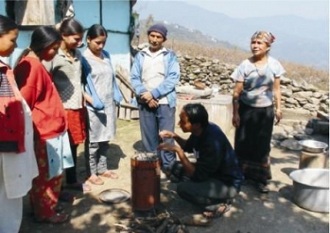International Journal of Collaborative Research on Internal Medicine & Public Health, Vol. 4 No. 1 (January 2012)
Does domestic cooking environment influence risk of respiratory morbidities in rural Indian women?
Neelam D Sukhsohale, Uday W Narlawar, Mrunal S Phatak, Suresh N Ughade
Background and objectives: Whether continued use of biomass fuels along with other fuels in presence of poor domestic cooking conditions is as detrimental to respiratory health as the exclusive use of biomass fuels is unknown. The present study is an attempt to assess the risks associated with indoor air pollution in the context of adverse domestic cooking environmental conditions in rural women of central India.
Methods: We conducted a community based, cross sectional study in 760 non-smoking, rural women of central India – 265 used non biomass fuels (Group A), 243 biomass and other fuels (Group B) while 252 exclusively biomass fuels (Group C). Exposure to domestic smoke was estimated according to the average time per day spent near the fireplace (exposure index). Abnormal pulmonary function of the study subjects was assessed by the measurement of peak expiratory flow rate (PEFR) according to standards recommended by American thoracic society. PEFR less than 80% of the predicted was considered as abnormal pulmonary function.
Background and objectives: Whether continued use of biomass fuels along with other fuels in presence of poor domestic cooking conditions is as detrimental to respiratory health as the exclusive use of biomass fuels is unknown. The present study is an attempt to assess the risks associated with indoor air pollution in the context of adverse domestic cooking environmental conditions in rural women of central India.
Results: Robust multivariate analyses which adjusted for height, illiteracy, physical activity, environmental exposure to tobacco smoke (ETS), mud house, overcrowding, inadequate ventilation and respiratory morbidity revealed that illiteracy (OR 2.48, 95 % CI 1.04 5.87); physical activity (OR 3.93, 95 % CI 1.52 10.14); inadequate cross ventilation (OR 2.43, 95 % CI 1.23-4.77) and respiratory morbidity (OR 2.65, 95 % CI 1.38-5.08) were significant predictors of low PEFR for group C (P<0.05); whereas none of the predictors were found to be significantly associated with group B.
Conclusions: Since women using partial biomass fuels showed no association of low PEFR with domestic cooking environment and respiratory morbidity even after robustly adjusting for confounding variables, we can conclude that even partial abolition of biomass use may be beneficial in improving the lung function of rural, non smoking women in spite of having inadequate domestic cooking environment.



